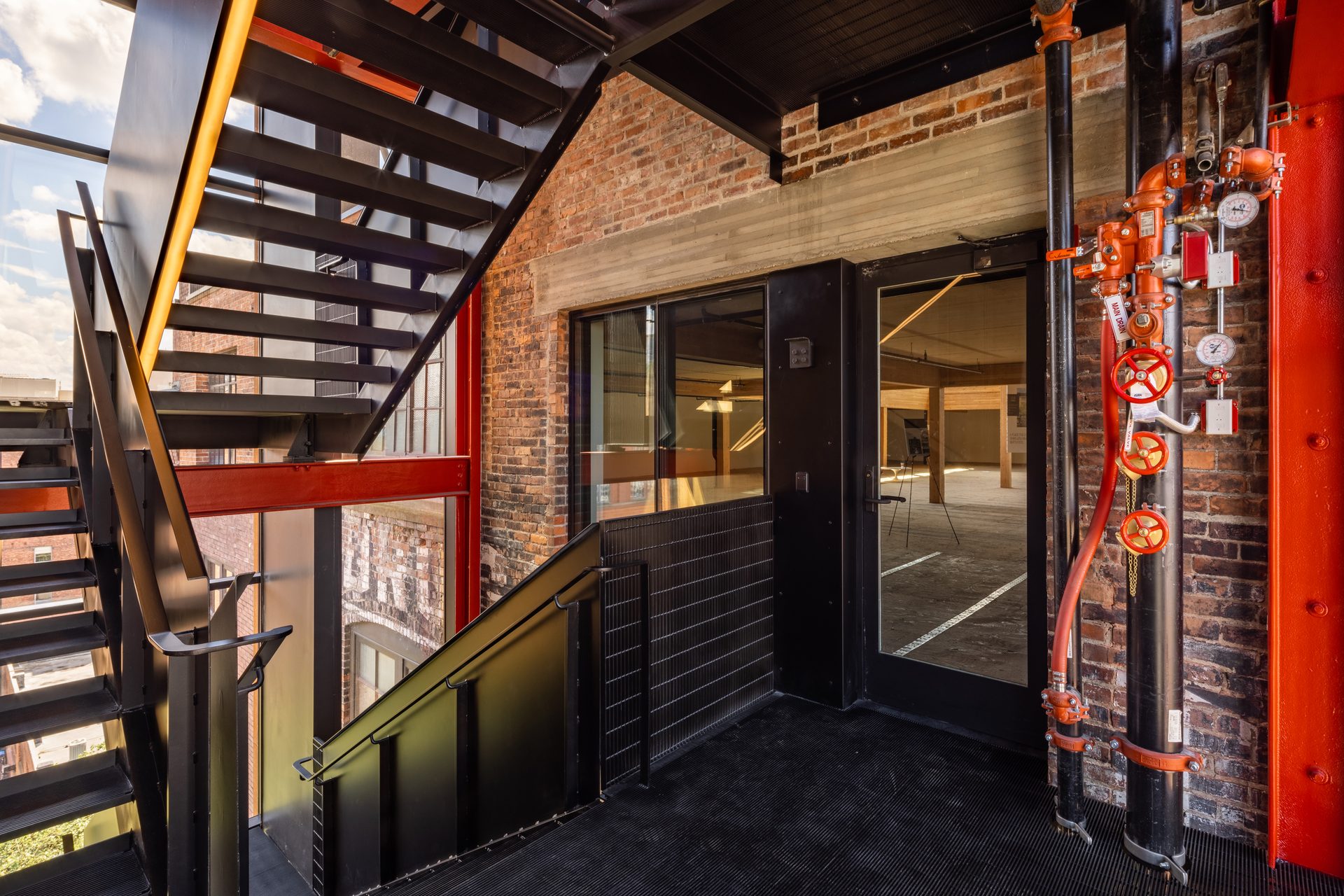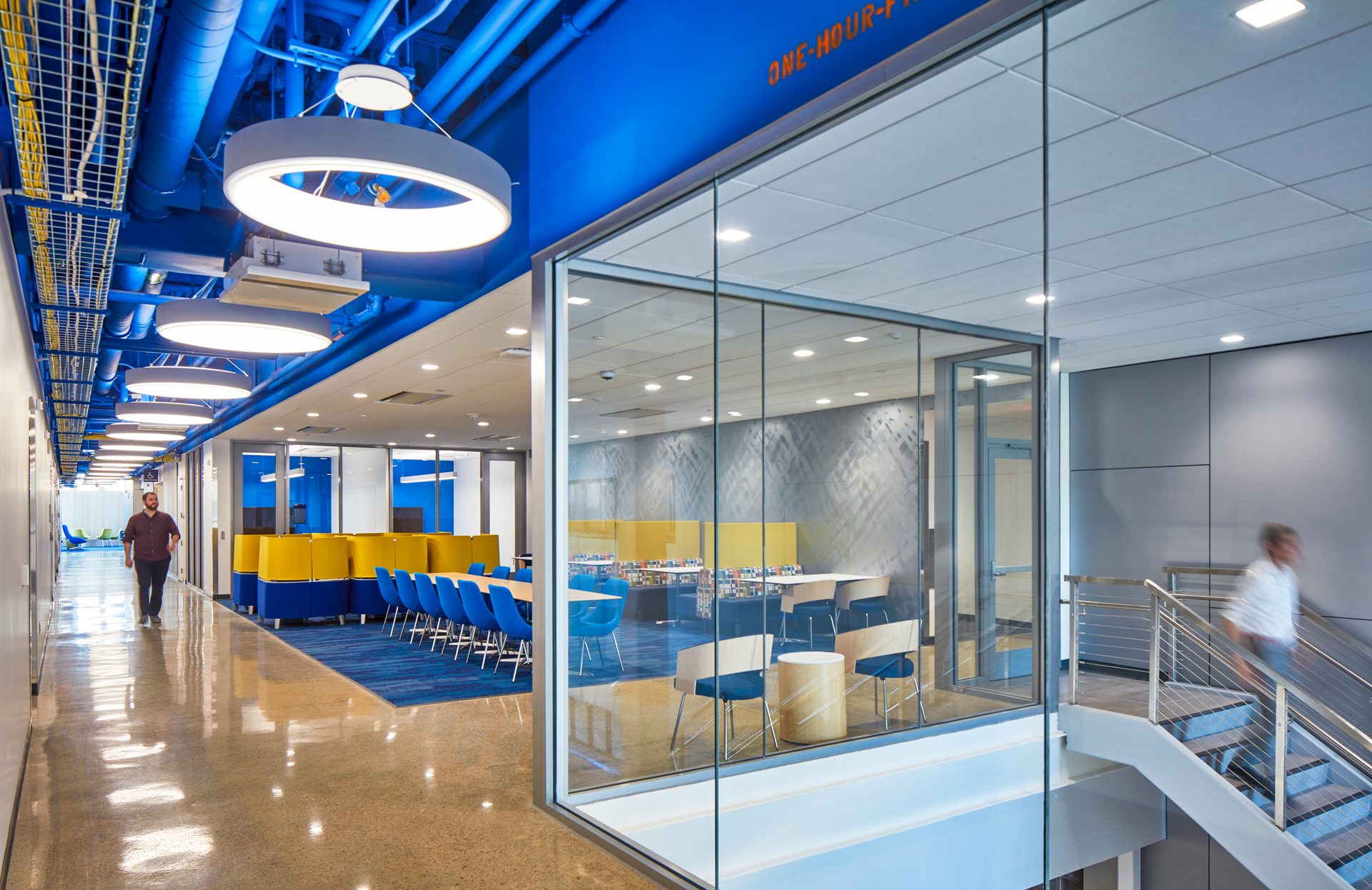Meeting code without sacrificing design. By Devin Bowman
Fire-Rated Glass in Stairwell Enclosures
No longer an afterthought, today's stairwells can invite people into buildings by supporting a bright and open design. In addition to enhancing the visual connection between spaces, well-designed stairwells also contribute intuitive wayfinding. However, when these features also require fire-resistive ratings, it can seem difficult to design a stairwell that is both beautiful and code compliant.
But advances in fire-resistive glass have changed that. Available in large, uninterrupted lites, this material, when paired with appropriately rated frames, not only satisfies fire-safety code requirements but also increases security and design aesthetics. As such, fire-resistive glazing assemblies can help architects meet critical fire- and life-safety standards issued from the International Code Council and the National Fire Protection Association while also allowing previously unattainable design possibilities for stairwell enclosures that require fire-resistive ratings.
With fire-resistive, wall-to-ceiling transparent wall panels, full-lite glass doors and even butt-glazed wall panel systems at their disposal, architects can create eye-catching designs and flood stairwell enclosures with natural light. They allow architects to open stairwell enclosures, ensuring a well-lit path for surer footing and allowing onlookers to easily see if someone has fallen or is involved in an altercation.
While design professionals no longer face the same constraints when it comes to stairwell design, success still hinges on appropriate use and knowing applicable codes and standards.
Codes to Know, Standards to Follow
It is important to note the International Building Code and NFPA only represent model code requirements for stairwell enclosures. Local authority having jurisdictions can modify these codes under certain circumstances. Additionally, a city may have its own requirements that go beyond what is listed within these manuals. It is recommended that designers contact AHJs to clarify any uncertainty concerning fire- and life-safety standards for a given project.
While code requirements can vary, testing standards are the same. For walls and windows, the ASTM E119, UL 263 and NFPA 251 are the most relevant standard tests. They detail which opaque and transparent assemblies satisfy the IBC and NFPA and are intended to approximate how long a material can provide protection from fire, heat and smoke in controlled settings.
For example, if an assembly can withstand fire, as defined by the standard, for one hour before its level of protection is compromised, then it would receive a 60-minute fire rating. The ratings these standards indicate span a range of times (usually between 20 to 120 minutes) and conditions (ratings of one-hour and above need to satisfy hose stream test requirements). Further, they can also indicate if a material is fire resistive (blocks flames, smoke and radiant heat) or fire protective (only blocks flames and smoke). Most codes require assemblies in stairwell enclosures to have a fire-resistive rating, but designers are encouraged to contact an AHJ for clarification.
Because advanced fire-resistive glazing can now be used in a variety of applications, there is almost always a solution available for code compliant stairwells that are a far cry from the dark and hidden designs of the past.

Full-lite fire-rated doors and windows use narrow-profile frames to provide a close visual match to non-rated systems. Credit: Courtesy of TGP
Fire-resistive Glazing Assemblies Balanace Open Design With Fire Barrier Requirements
Stairwells can be points of visual connection between levels. While the most straightforward means to accomplish visual connection between levels is with designs that are completely open—utilizing handrails and balustrades as safety systems, sometimes a fire barrier is needed due to the type of stairwell or the square footage of combined levels. Fire barriers isolate parts of the built environment to protect occupants and to slow the spread of heat, fire and smoke.
Nearly all stairwells in areas of egress will need to meet this requirement and be rated for 60 to 120 minutes according to ASTM E119. Further, stairwells that connect floors with a combined square footage above a certain threshold for the building type will also need to incorporate a fire-resistive barrier.
Traditionally, these barriers have been mostly opaque, incorporating small “lites” of fire-protective glass sparingly, if at all. Accordingly, if a stairwell needed to incorporate a fire barrier, it almost always limited the choices an architect could make. However, fire-resistive glazing assemblies now allow designers to create nearly open designs that also provide fire barriers between spaces. This not only contributes to easy wayfinding by allowing occupants to see what’s on neighboring floors, but it can also meet design intentions that focus on creating a bright, open interior.

Nearly unobstructed floor to ceiling fire-rated glass panels ensure visual connectivity between levels. Credit: Courtesy of Tom Harris Photograph and TGP
The Role of Fire-Rated Frames in Modern Stairwell Design
While the glass is often the most focused on aspect of fire-rated glazing assemblies in stairwell enclosures, the frames are equally important. Not only do they need to have the strength to hold the increased weight of fire-resistive rated glass, which can be four times the weight of standard lites, but it is also important that they do not draw unnecessary attention to themselves with increased bulkiness. Narrow-profile fire-rated frames can satisfy both concerns.
Handling the increased weight of fire-rated glazing without compromising the large spans of uninterrupted glass, narrow-profile fire-rated frames can also offer a close visual match to non-rated systems for a cohesive design aesthetic across the built environment.
While concerns about cohesive design touch most areas of a building, they receive extra importance in stairwell design, where tight spaces increase the opportunity for rated and non-rated systems to be within the same view. Beyond design, maximizing the glazing area also contributes to occupant security by opening sightlines.
As shown in a recent renovation to the 419 Occidental Ave mixed-use building in Seattle, Wash., the architects chose fire-rated framing systems for the door and window assemblies that allow the passage of daylight into the building and visually complement the glass curtain walls on the east and west ends of the stairwell. The fire-resistive frames used for the project were narrow to maximize the glazing area—providing code compliance without sacrificing design goals.
Going Beyond Utilitarian Stairwell Designs With Fire-resistive Butt-glazed Assemblies
For seamless designs that also provide fire barriers between spaces, architects can turn to fire-resistive butt-glazed assemblies. By removing the need for a vertical mullion, these systems allow for nearly uninhibited connection between areas. This helps balance the seemingly opposed forces of open design and stringent fire-safety requirements.
The stairwells in the William R. Murchie Science Building at the University of Michigan – Flint provide a compelling example of striking this balance. The building’s open design was meant to foster collaboration and interdepartmental dialogue but the floorplan needed a fire barrier to pass inspection. To achieve both code compliance and design intent, the architects incorporated fire-rated, butt-glazed assemblies to provide nearly unobstructed openness without compromising critical fire and life safety.
Fire-Resistive Glazing Elevates Stairwell Enclosures
Because they’re able to meet critical fire- and life-safety requirements as well as create stunning designs, fire-resistive rated glazing systems have transformed stairwells from utilitarian architectural features to spaces that support occupant comfort and safety. While previously they may not have elicited much excitement, stairwell enclosures that incorporate fire-rated glazing now have the potential to inspire the next generation of designers.
Opening Image: Fire-rated, butt-glazed assemblies support open floor designs without compromising safety. Credit: Courtesy of Tom Harris Photograph and TGP
Devin Bowman is general manager of Technical Glass Products and AD Systems. With nearly 20 years of industry experience, Bowman is actively involved in advancing fire- and life-safety codes and sits on the Glazing Industry Code Committee. For more information, email Devin.Bowman@allegion.com.

